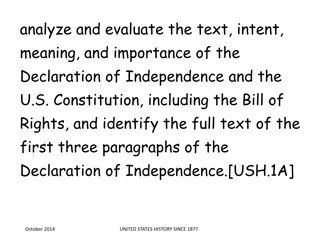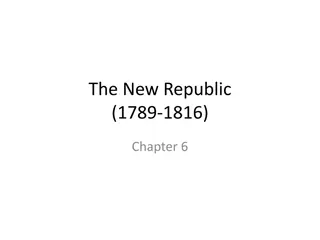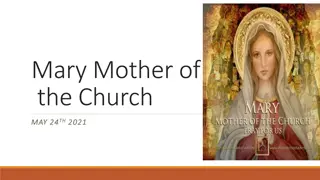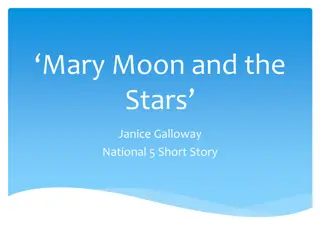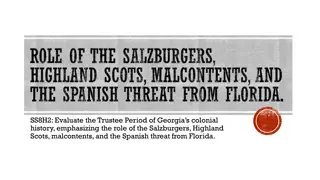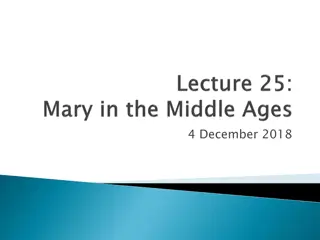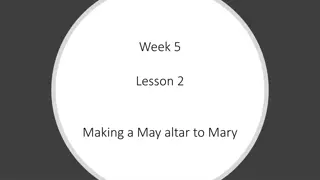The Founding of Savannah: Oglethorpe, Tomochichi, and Mary Musgrove
On October 6th, 2016, James Oglethorpe, Chief Tomochichi of the Yamacraw tribe, and Mary Musgrove played crucial roles in the establishment of Savannah, Georgia. Oglethorpe, an Englishman, founded the colony and convinced King George II to grant a charter for colonization. Tomochichi, a Yamacraw chief, befriended Oglethorpe and allowed colonists to settle on Yamacraw Bluff after signing the Treaty of Savannah. Mary Musgrove, a translator and trader, facilitated peaceful relations between Indians and colonists. The town of Savannah was planned with a unique grid system, attracting immigrants from various backgrounds.
Download Presentation

Please find below an Image/Link to download the presentation.
The content on the website is provided AS IS for your information and personal use only. It may not be sold, licensed, or shared on other websites without obtaining consent from the author. Download presentation by click this link. If you encounter any issues during the download, it is possible that the publisher has removed the file from their server.
E N D
Presentation Transcript
PART FOUR Important People, Establishing Savannah, the SALZBURGERS & HIGHLAND SCOTS October 6th2016
About 18 Miles Upriver From The Ocean, Oglethorpe Found A Large Flat Area (Yamacraw Bluff/Savannah) Area was close to friendly Indians and a Carolina trading post. (John & Mary Musgrove) Oglethorpe would have to ask permission from the local Yamacraw Indians for permission to settle the area.
Chief Tomochichi Yamacraw His tribe depended on English trading He believed that a new English settlement would help his tribe and agrees to allow the colonists to settle Oglethorpe and Tomochichi would become lifelong friends. Traveled to Great Britain
EQ: What role did James Oglethorpe, Tomochichi, and Mary Musgrove play in the colonization of Georgia? Tomochichi Mary Musgrove James Oglethorpe Englishman who founded the colony of Georgia of Savannah. Served in British military and Parliament and convinced King George II to grant him a charter to colonize Georgia with English citizens who were in debt founded the Daughter of an English trader and Creek Indian mother. She served as a translator for Tomochichi and Oglethorpe and helped the peaceful relationship between Indians and colonists by operating a trading post in Savannah Chief of the Yamacraw Indians Became friends with Oglethorpe and allowed colonists to settle on Yamacraw Bluff in order to trade with the English. Traveled to England and convinced his own people the English had good intentions of colonizing the land in Georgia. Signed Treaty of Savannah. Yamacraw Indians. colony of Georgia and built the city allowed colonists to settle on Yamacraw Bluff near Savannah River translator for Tomochichi and Oglethorpe convinced charter to colonize Georgia with English citizens who were in debt. Resident Trustee. his own people the English had good intentions of colonizing the land in Georgia. Signed Treaty of Savannah. operating a trading post in Savannah.
The Town of Savannah Was Laid Out Using A Special Plan Named after the nearby Savannah River Trees had to be cleared for farmland and living space The settlement would be laid out in a series of squares, making a grid pattern Each public square was the center of a neighborhood
Oglethorpe Square Savannah s Grid System Layout
Immigrants From All Over The World Came to Savannah Diseases had depleted the original population of the colony (40 died) Dr Samuel Nunis 44 Jews Immigrants from almost every European country 34 Salzburgers John Martin Bolzius Ebenezer, GA - antislavery 36 Salzburgers, Moravians, - John & Charles Wesley Frederica on St Simons Island 36 Scottish Highlanders Darien defense & antislavery
ROLE OF THE SALZBURGERS AND HIGHLAND SCOTS MAKE A T MAKE A T- -CHART IN YOUR NOTES CHART IN YOUR NOTES WHO: HIGHLAND SCOTS WHAT: WHO: SALZBURGERS WHAT: WHEN: WHERE: WHEN: WHERE: WHY: WHY:
SALZBURGERS The Georgia Salzburgers, a group of German-speaking Protestant colonists, founded the town of Ebenezer in what is now Effingham County. Arriving in 1734, the group received support from King George II of England and the Georgia Trustees after being expelled from its home in the Catholic principality of Salzburg (in present-day Austria). The Salzburgers survived extreme hardships in both Europe and Georgia to establish a prosperous and culturally unique community. New Georgia Encyclopedia
SALZBURGERS key points 1734 - came to Georgia after being expelled from Germany / Austria for not being Catholic Protestants who wanted religious freedom Created the town of Ebenezer, but was too swampy to survive Relocated to the town of New Ebenezer along Savannah River became a very religious community, also had silk mills Trustees liked the hard working Salzburgers because they did not like slavery or alcohol which were rules the colonists had to live by
HIGHLAND SCOTS James Oglethorpe wanted to protect the Georgia colony from possible attacks from Spanish Florida. The men of Scotland had the reputation of being good soldiers, and so Oglethorpe recruited a group of about 175 Highland Scots to settle in the area south of Savannah. The group arrived at the Altamaha River in 1736 and established a settlement they originally called New Inverness. Later, they changed the name to Darien. Dr. Glen Blankenship and Vicki Wood
HIGHLAND SCOTS Came to Georgia in 1736 from Scotland Built the town / fort of Darien south of Savannah along the Altamaha River Reputation of hard working people who were good soldiers Protected the Georgia colony from Spanish Florida helped Oglethorpe push the Spanish out of Georgia in the Battle of Bloody Marsh Changed from farming to cattle raising and harvesting timber
HIGHLAND SCOTS Whatever you forget about the Highland Scots between now and the CRCT, at least remember this The Highland Scots were soldiers who colonized Georgia by creating the town of Darien and helped defend the colony from the Spanish during the Battle of Bloody Marsh. Opposed slavery in the colony
ROLE OF THE SALZBURGERS AND HIGHLAND SCOTS WHO: SALZBURGERS WHAT: GROUP OF PROTESTANT PEOPLE FROM EUROPE (GERMANY / AUSTRIA) WHO HELPED COLONIZE GEORGIA WHEN: 1734 WHERE: BUILT THE TOWN OF NEW EBENEZER NORTHWEST OF SAVANNAH ALONG THE SAVANNAH RIVER. WHY: ESCAPED RELIGIOUS PERSECUTION FROM CATHOLIC CONTROLLED GERMANY / AUSTRIA WHO: HIGHLAND SCOTS WHAT: GROUP OF SOLDIERS FROM SCOTLAND WHO HELP COLONIZE GEORGIA AND DEFEND THE COLONY FROM THE SPANISH WHEN: 1736 WHERE: BUILT THE TOWN & FORT CALLED DARIEN ALONG THE ALTAMAHA RIVER AND RAISED CATTLE AND TIMBER WHY: OGLETHORPE NEEDED THEIR MILITARY HELP TO DEFEAT THE SPANISH DURING THE BATTLE OF BLOODY MARSH
Life Was Hard, And Some Colonists Began to Grumble Malcontents Patrick Tailfer & Thomas Stephens 1735-1740 (not charity cases) Hot weather and frequent, heavy rains made life uncomfortable Insects carried diseases that killed many colonists Colonists began to leave Georgia
Malcontents biggest objections Land could only be passed down to male children (no women could own property nor could you purchase more) Slavery was not allowed Colonists were not allowed to drink rum Self-government was limited/nonexistent
MALCONTENTS Whereas many of Georgia's original settlers came with monetary aid from the Trustees, most of the Malcontents arrived without assistance and thus did not have the same loyalty to the colony's founders. In particular, the Malcontents objected to the Trustees' limits on land ownership and prohibitions on slavery and rum. Since the Malcontents could afford to purchase slaves and vast tracts of land, they felt the policies of the Trustees prevented them from realizing their economic potential. - New Georgia Encyclopedia
PRIMARY SOURCE DOCUMENT During the 1730s, Scottish settler Patrick Tailfer led a group of colonists, knowns as the Malcontents, in protest of various laws and policies enforced by the Georgia Trustees. - New Georgia Encyclopedia
COMPARING TWO COLONIES GEORGIA GEORGIA SOUTH CAROLINA SOUTH CAROLINA TRUSTEE COLONY NO SLAVERY NO RUM LAND LIMITS 500 acres FEMALE COULD NOT INHERIT LAND FORCED TO GROW MULBERRY TREES, GRAPES, AND INDIGO PLANTS STRUGGLED TO MAKE MONEY ROYAL COLONY SLAVERY WAS ALLOWED TRADE RUM WITH INDIANS NO LAND LIMITS FEMALES COULD INHERIT LAND COULD GROW COTTON, RICE, AND TOBACCO VERY PROFITABLE ROYAL COLONY SLAVERY WAS ALLOWED TRADE RUM WITH INDIANS NO LAND LIMITS FEMALES COULD INHERIT LAND COULD GROW COTTON, RICE, AND TOBACCO VERY PROFITABLE
The Trustees Wanted To Prevent A Rich Upper Class 1.) Trustees refused to issue new land grants 2.) Colonists were prohibited from selling or leasing their land





